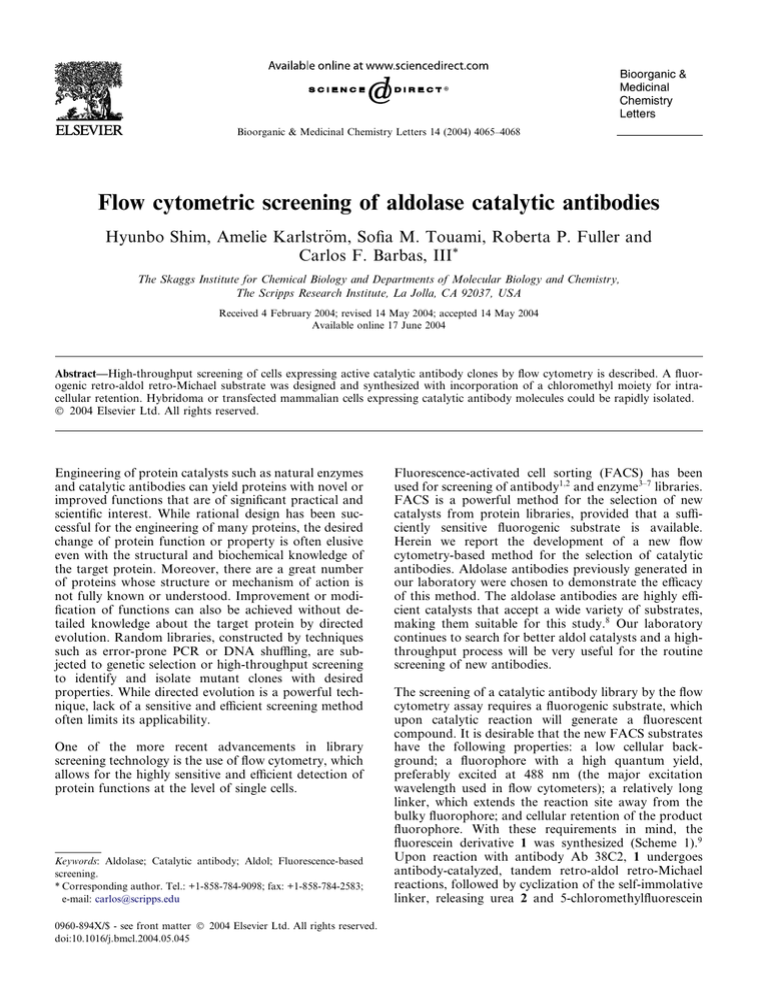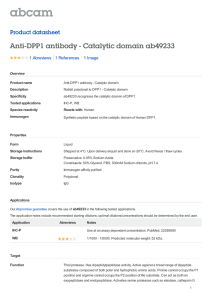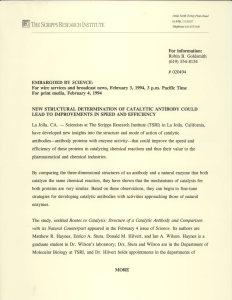
Bioorganic & Medicinal Chemistry Letters 14 (2004) 4065–4068
Flow cytometric screening of aldolase catalytic antibodies
€m, Sofia M. Touami, Roberta P. Fuller and
Hyunbo Shim, Amelie Karlstro
Carlos F. Barbas, III*
The Skaggs Institute for Chemical Biology and Departments of Molecular Biology and Chemistry,
The Scripps Research Institute, La Jolla, CA 92037, USA
Received 4 February 2004; revised 14 May 2004; accepted 14 May 2004
Available online 17 June 2004
Abstract—High-throughput screening of cells expressing active catalytic antibody clones by flow cytometry is described. A fluorogenic retro-aldol retro-Michael substrate was designed and synthesized with incorporation of a chloromethyl moiety for intracellular retention. Hybridoma or transfected mammalian cells expressing catalytic antibody molecules could be rapidly isolated.
2004 Elsevier Ltd. All rights reserved.
Engineering of protein catalysts such as natural enzymes
and catalytic antibodies can yield proteins with novel or
improved functions that are of significant practical and
scientific interest. While rational design has been successful for the engineering of many proteins, the desired
change of protein function or property is often elusive
even with the structural and biochemical knowledge of
the target protein. Moreover, there are a great number
of proteins whose structure or mechanism of action is
not fully known or understood. Improvement or modification of functions can also be achieved without detailed knowledge about the target protein by directed
evolution. Random libraries, constructed by techniques
such as error-prone PCR or DNA shuffling, are subjected to genetic selection or high-throughput screening
to identify and isolate mutant clones with desired
properties. While directed evolution is a powerful technique, lack of a sensitive and efficient screening method
often limits its applicability.
One of the more recent advancements in library
screening technology is the use of flow cytometry, which
allows for the highly sensitive and efficient detection of
protein functions at the level of single cells.
Keywords: Aldolase; Catalytic antibody; Aldol; Fluorescence-based
screening.
* Corresponding author. Tel.: +1-858-784-9098; fax: +1-858-784-2583;
e-mail: carlos@scripps.edu
0960-894X/$ - see front matter 2004 Elsevier Ltd. All rights reserved.
doi:10.1016/j.bmcl.2004.05.045
Fluorescence-activated cell sorting (FACS) has been
used for screening of antibody1;2 and enzyme3–7 libraries.
FACS is a powerful method for the selection of new
catalysts from protein libraries, provided that a sufficiently sensitive fluorogenic substrate is available.
Herein we report the development of a new flow
cytometry-based method for the selection of catalytic
antibodies. Aldolase antibodies previously generated in
our laboratory were chosen to demonstrate the efficacy
of this method. The aldolase antibodies are highly efficient catalysts that accept a wide variety of substrates,
making them suitable for this study.8 Our laboratory
continues to search for better aldol catalysts and a highthroughput process will be very useful for the routine
screening of new antibodies.
The screening of a catalytic antibody library by the flow
cytometry assay requires a fluorogenic substrate, which
upon catalytic reaction will generate a fluorescent
compound. It is desirable that the new FACS substrates
have the following properties: a low cellular background; a fluorophore with a high quantum yield,
preferably excited at 488 nm (the major excitation
wavelength used in flow cytometers); a relatively long
linker, which extends the reaction site away from the
bulky fluorophore; and cellular retention of the product
fluorophore. With these requirements in mind, the
fluorescein derivative 1 was synthesized (Scheme 1).9
Upon reaction with antibody Ab 38C2, 1 undergoes
antibody-catalyzed, tandem retro-aldol retro-Michael
reactions, followed by cyclization of the self-immolative
linker, releasing urea 2 and 5-chloromethylfluorescein
4066
H. Shim et al. / Bioorg. Med. Chem. Lett. 14 (2004) 4065–4068
Scheme 1. Synthesis of substrate 1. Reaction conditions: (a) TFA,
10 min at rt, acid removed in vacuo and immediately added to the
reaction mixture b; (b) THF, 1 equiv 4-nitrophenylchloroformate, 0 C,
1 equiv TEA added dropwise, 2 h; (c) excess TEA, rt, 16 h. Product
purified by preparative TLC (ethyl acetate). The preparation of the
starting materials followed the procedures described in Refs. 15 and
16.
Scheme 2. Retro-aldol, retro-Michael reaction of substrate 1 catalyzed
by aldolase antibody 38C2.
(Scheme 2). The tandem reactions significantly reduce
the background reaction rate. The chloromethyl moiety
reacts with nucleophiles inside the cell (e.g., glutathione
or other intracellular sulfhydryl groups), thus retaining
the product within the cell.6;10;11 Compound 1 was first
tested with purified Ab 38C2 and shown to be a substrate for this catalyst, as monitored by the release of 5chlorofluorescein (kcat ¼ 0:018 min1 , Km ¼ 22 lM).
Cell-based studies were then undertaken to confirm the
specificity of these compounds as probes for aldolase
activity. To assess the possibility of sorting cells based
on their catalytic activity, hybridoma cells expressing Ab
38C2 or non-catalytic Ab 29B4 were mixed prior to
incubation with the substrate 1. After reacting for 4 h,
the cells were analyzed by flow cytometry, as shown in
Figure 1.12 Two distinct populations of cells, with different fluorescence intensities, are clearly observed in
this experiment. In addition, the peak ratios correlate to
the ratios of catalytic versus non-catalytic cells. These
results clearly demonstrate that the discrimination of
cells expressing catalytic antibody from cells without
catalyst is possible using fluorogenic aldol sensors. The
assay was then tested by sorting 10 million cells containing a predetermined mixture of 90% 29B4 and 10%
Figure 1. Mixed cultures of JW 38C2 and JW2 29B4 hybridoma cells
incubated with 10 lM substrate 1 for 4 h. A, 38C2 only, B,
38C2:29B4 ¼ 3:1, C, 38C2:29B4 ¼ 1:1, D, 38C2:29B4 ¼ 1:3, E, 29B4
only.
38C2-expressing hybridoma cells.12 After incubation
with aldolase substrate 1, positive cells were recovered
by selection of viable cells that exhibited the highest
fluorescence intensity at 530 nm (Fig. 2, R3). The
1.1 · 105 positive cells thus obtained were cultured and
re-analyzed by flow cytometry to confirm the enrichment of catalytically active cells, as shown in Figure 2
(red histogram).
Figure 2. Cells were sorted based on propidium iodide stain (R1), on
low-to-moderate side scatter (R2), and on high FL2 signal (R3) were
sorted by FACStar Plus. FACS analysis after regrowth of the sorted
cells shows high FL2 signal (red histogram) relative to negative control
(blue histogram).
H. Shim et al. / Bioorg. Med. Chem. Lett. 14 (2004) 4065–4068
The selection of hybridoma cells producing catalytic
antibodies is only one possible application for the
method described above. Recently developed techniques
for the generation of genetic diversity, such as DNA
shuffling and mutagenic PCR, have been successfully
used to produce libraries from which enzymes with new
properties can be evolved. With correct design of fluorogenic substrates a variety of different reactions can
be monitored using a linker that separates the site of the
reaction from the fluorophore.
We have tested the potential of the method for the isolation of catalysts from a plasmid-encoded library
introduced and expressed in mammalian cells. The human 293T cell line was transfected with recombinant
38C2 and analyzed by flow cytometry.13;14 As a control,
cells were transfected with an inactive mutant of 38C2
cloned into the same expression vector. After incubation
with substrate 1 the cellular fluorescence was analyzed
by flow cytometry to confirm that the catalytic activity
of Ab 38C2 could be detected in the transiently transfected cells and the product fluorescence was well resolved from that of the background reaction in the
control cells (Fig. 3).
In conclusion, a novel cell-based assay for the reactionbased selection of aldolase antibodies is presented.
Fluorogenic aldol sensors for FACS were designed and
synthesized. The reaction sensors could be selectively
converted to products that are trapped inside cells
expressing functional catalysts, allowing for cell selection by flow cytometry. By using this method it is possible to rapidly screen hybridoma cells in order to
identify clones that express catalytic antibodies. In
addition, we have also shown that mammalian cells that
transiently express recombinant aldolase antibody catalysts can also be selected suggesting that the methodology will be applicable to recombinant library
screening as well. Thus this selection should find utility
in the identification and evolution of novel aldolase
antibodies or enzymes. Since the aldol sensors share the
retro-aldol retro-Michael trigger mechanism common to
our aldolase activated prodrugs, this methodology may
facilitate the selection of catalysts that are optimized
with respect to their ability to activate the multireaction
Figure 3. FACS analysis of transiently transfected 293T cells. Green:
transfected with 38C2 IgG, blue: negative control.
4067
trigger and thus improve the potential of aldolase antibody prodrug therapy.15;17
Acknowledgements
This study was supported in part by the NIH (CA27489)
and The Skaggs Institute for Chemical Biology.
References and notes
1. Daugherty, P. S.; Chen, G.; Olsen, M. J.; Iverson, B. L.;
Georgiou, G. Protein Eng. 1998, 11, 825–832.
2. Chen, G.; Hayhurst, A.; Thomas, J. G.; Harvey, B. R.;
Iverson, B. L.; Georgiou, G. Nat. Biotechnol. 2001, 19,
537–542.
3. Nolan, G. P.; Fiering, S.; Nicolas, J. F.; Herzenberg, L. A.
Proc. Natl. Acad. Sci. U.S.A. 1988, 85, 2603–2607.
4. Russo-Marie, F.; Roederer, M.; Sager, B.; Herzenberg, L.
A.; Kaiser, D. Proc. Natl. Acad. Sci. U.S.A. 1993, 90,
8194–8198.
5. Wittrup, K. D.; Bailey, J. E. Cytometry 1988, 9, 394–404.
6. Plovins, A.; Alvarez, A. M.; Ibanez, M.; Molina, M.;
Nombela, C. Appl. Environ. Microbiol. 1994, 60, 4638–
4641.
7. Olsen, M. J.; Stephens, D.; Griffiths, D.; Daugherty, P.;
Georgiou, G.; Iverson, B. L. Nat. Biotechnol. 2000, 18,
1071–1074.
8. Wagner, J.; Lerner, R. A.; Barbas, C. F., III. Science 1995,
270, 1797–1800.
9. Experimental data for substrate 1. 1 H NMR (CD3 OD,
300 MHz): 1.25 (s, 3H), 1.89 (m, 2H), 2.11 (s, 3H), 2.62 (m,
2H), 3.05 (m, 10H), 4.19 (br, 2H), 4.84 (s, 2H), 6.58 (m,
0.4H), 6.68 (m, 0.6H), 6.84 (m, 4H), 7.18 (m, 1.2H), 7.82
(m, 0.8H), 8.08 (m, 2H). HRMS (MHþ ) calculated for
C34 H36 ClO10 N2 : 667.1980; observed: 667.2024.
10. Zhang, Y. Z.; Naleway, J. J.; Larison, K. D.; Huang, Z. J.;
Haugland, R. P. FASEB J. 1991, 5, 3108–3113.
11. Poot, M.; Arttamangkul, S. Cytometry 1997, 28, 36–41.
12. JW 38C2 and JW 29B4 cells were counted with a
hemocytometer and mixed. 5 · 105 (for analysis) or
1 · 108 (for sorting) mixed cells were incubated in RPMI
(Life Technologies, Gaithersburg, MD) supplemented with
10% fetal bovine serum (Life Technologies), antibioticantimycotic reagent (Life Technologies) and the substrate 1
(10 lM from 10 mM DMSO stock) for 4 h at 37 C in a
humidifying atmosphere of 5% CO2 . After incubation the
cells were washed once with FACS sorting buffer (1 · PBS,
1 mM EDTA, 25 mM HEPES, pH 7.0, and 1% dialyzed
FBS) and trypsinized and resuspended in 3 mL FACS
sorting buffer with 1 lgmL1 PI. Cells were analyzed on a
FACS can flow cytometer or sorted on a FACStar PLUS
flow cytometer (Becton Dickinson, San Jose, CA). The
trigger parameter was set to FSC. The product of substrate
1 was monitored by excitation with an argon ion laser
(wavelength, 488 nm) and the emission was detected in the
FL-1 channel via a 530/30 nm filter. PI staining of dead
cells was monitored by excitation with the same laser and
emission detection in the FL-3 channel via a 650 nm long
pass filter (FACScan) or 630/22 nm filter (FACStar plus),
and the autofluorescence of the cells was detected in the
FL-2 channel via a 585/42 nm filter. The cells were gated in
FSC versus PI, in FL-1 versus FL-2 and in SSC (Fig. 2).
1.1 · 105 cells were collected in Normal-R mode using a
4068
H. Shim et al. / Bioorg. Med. Chem. Lett. 14 (2004) 4065–4068
100 lm nozzle into 1 mL fetal bovine serum (Life Technologies, Gaithersburg, MD) and recultured for analysis.
13. The VL and VH chains of the Ab 38C2 gene were cloned
into the pIGG-8 vector for the transfection experiments.
As a control, the non-catalytic antibody LM609 cloned
into the pIGG-8 vector was used. Human embryonic
kidney 293T cells were transfected with pIGG-8 constructs
by LipofectAMINE PLUS (Life Technologies, Gaithersburg, MD) according to the procedure recommended by
the manufacturer. On the day after transfection, the
medium was replaced with fresh medium and substrate 1
was added to a final concentration of 10 lM. The cells
were incubated for additional 8 h then were analyzed or
sorted as described above. Positive cells (99 percentile or
higher fluorescence) were collected and the antibody genes
were obtained in one of the three ways: (1) plasmid was
recovered from the cells,12 (2) antibody gene was amplified
by PCR from the isolated plasmid and cloned into pIGG-8
vector, or (3) total RNA was retrieved using TRI reagent
14.
15.
16.
17.
(Molecular Research Center) and the antibody gene was
amplified by RT-PCR, followed by cloning into pIGG-8
vector. The resulting plasmids were amplified by transformation into XL1-Blue (Stratagene, La Jolla, CA) or
SURE (Stratagene, La Jolla, CA) E. coli cells and were
analyzed by DNA sequencing, analytical PCR or FACS
analysis.
Higuchi, K.; Araki, T.; Matsuzaki, O.; Sato, A.; Kanno,
K.; Kitaguchi, N.; Ito, H. J. Immunol. Meth. 1997, 202,
193–204.
Shabat, D.; Lode, H. N.; Pertl, U.; Reisfeld, R. A.; Rader,
C.; Lerner, R. A.; Barbas, C. F., III. Proc. Natl. Acad. Sci.
U.S.A. 2001, 98, 7528–7533.
Haugland, R. P.; You, W.; Paragas, V. B.; Wells, K. S.;
DuBose, D. A. J. Histochem. Cytochem. 1994, 42, 345–
350.
Rader, C.; Turner, J. M.; Heine, A.; Shabat, D.; Sinha, S.
C.; Wilson, I. A.; Lerner, R. A.; Barbas, C. F., III. J. Mol.
Biol. 2003, 332, 889–899.




